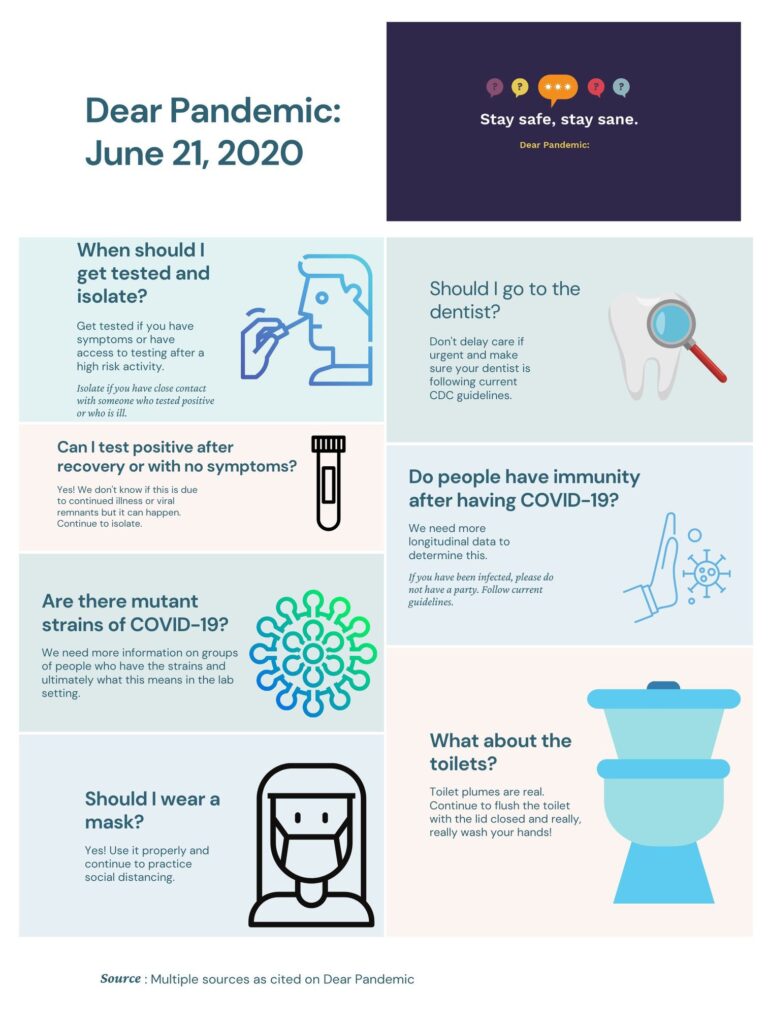We also have a brief infographic for you that answers these questions. Read on if you want the full answers and links. And if you have time, test your COVID-19 knowledge and read a few great tips from therapists on how to cope during this pandemic.

WHAT IF I KEEP TESTING POSITIVE FOR COVID-19 AND I DON’T HAVE SYMPTOMS?
If you test positive, it is possibly reflecting infection from weeks earlier. Still, it could indicate active infection or viral shedding. However, unfortunately policy will dictate when and if loved ones can stop isolation after testing positive.
Link: HuffPost
WHAT IF I TESTED POSITIVE FOR COVID-19 AND DON’T HAVE SYMPTOMS?
If you test positive and don’t have symptoms, you will likely need to isolate for 10-14 days (based on your clinician’s recommendations). You may have tested when you were presymptomatic and thus will develop symptoms. If no symptoms after that time period, you are free to go on with your life.
Link: NPR
WHAT IF SOMEONE IN MY HOUSEHOLD TESTS POSITIVE FOR COVID-19?
You should do your best to isolate from them and also self-isolate from others for 14 days.
Link: CDC
WHAT IF SOMEONE I WORK WITH TESTED POSITIVE (BUT WE WERE BOTH WEARING MASKS AND SOCIALLY DISTANCED)?
If you were in “close contact” with the person you should still self-isolate.
Link: CDC
WHAT ABOUT THE NEW NORTHWESTERN STUDY NOTING THAT THE CORONAVIRUS STRAINS IN CHICAGO ARE DIFFERENT AND POTENTIALLY MORE SERIOUS (CAUSE MORE RESPIRATORY DAMAGE)?
We have not yet seen the paper out, but here is an article from The Atlantic we cited earlier:
In May it seemed early to make these claims. We needed more time to know if different strains existed and if so, if some were more or less dangerous than others. Simply because one strain appears to affect one group of people does not mean it is more virulent. It could be that there are other factors (i.e. comorbidities, poverty). And therefore, we would need to know how this was studied in the lab to likely draw conclusions.
SHOULD I KEEP WEARING A MASK IN GENERAL SETTINGS EVEN IF I DON’T HAVE SPECIFIC EVIDENCE ON WEARING A MASK TO PREVENT COVID-19?
Yes, we recently cited this study, which included three studies from non-healthcare settings during the SARS outbreak. We also know a bit more about viral transmission and dynamics. Because the virus is primarily transmitted from person to person, in close contact, and through respiratory droplets, it makes sense to reduce the possibility of spewing droplets on another person. The mask then provides a barrier from the infected person so droplets are more likely to stay in the mask and also spare the other person from coming into contact with as many droplets. Remember the choir practice where 87% were infected?
Even so, the mask should cover the nose and mouth. You should not touch the exterior of the mask. And you should change/remove the mask if it is soiled. This is tricky in the summer and for little ones, but we can do our best, especially when in crowded settings! For children 2-12, it could be difficult to wear properly and therefore, may require adult supervision (otherwise it is not effective and may be better to remove). We also recognize that not everyone can wear a face covering and want to share some potential exemptions.
SHOULD I RECEIVE DENTAL CARE?
As with many recommendations, it depends on your specific situation (is it urgent) and your community (what does transmission look like). After that is considered, you can think about what your dental practice is doing with regards to current CDC guidance.
Link: The New York Times
In the News!
NO IMMUNITY?
News broke that people who have had COVID-19 may only have immunity for 2-3 months. Our response: We need more data. We specifically need data over time (longitudinal data) to determine this. And it supports our recommendations for physical distancing, wearing a mask, and staying outdoors this summer.
Link: The New York Times
NO SPIKE IN CASES?
We are not yet sure if we will see a spike in cases after protests. Our response: It is still early to tell but people who have attended protests may be wise to isolate for 14 days after and get tested if symptoms develop (or if not if widely available testing near you).
Link: WCVB & Mayor Durkan’s Office
TOILET PLUMES ARE BACK?
Listen to us, just close the lid when you flush. Then wash your hands. A lot.
Link: The New York Times
MORE DATA!
The COVID tracking project is also including data from all communities.
LONGHAULERS
Many people have reported long term symptoms after COVID-19 infection. We are still trying to understand this, but in the meantime, support groups seem to be popping up for those affected. Read more here.


